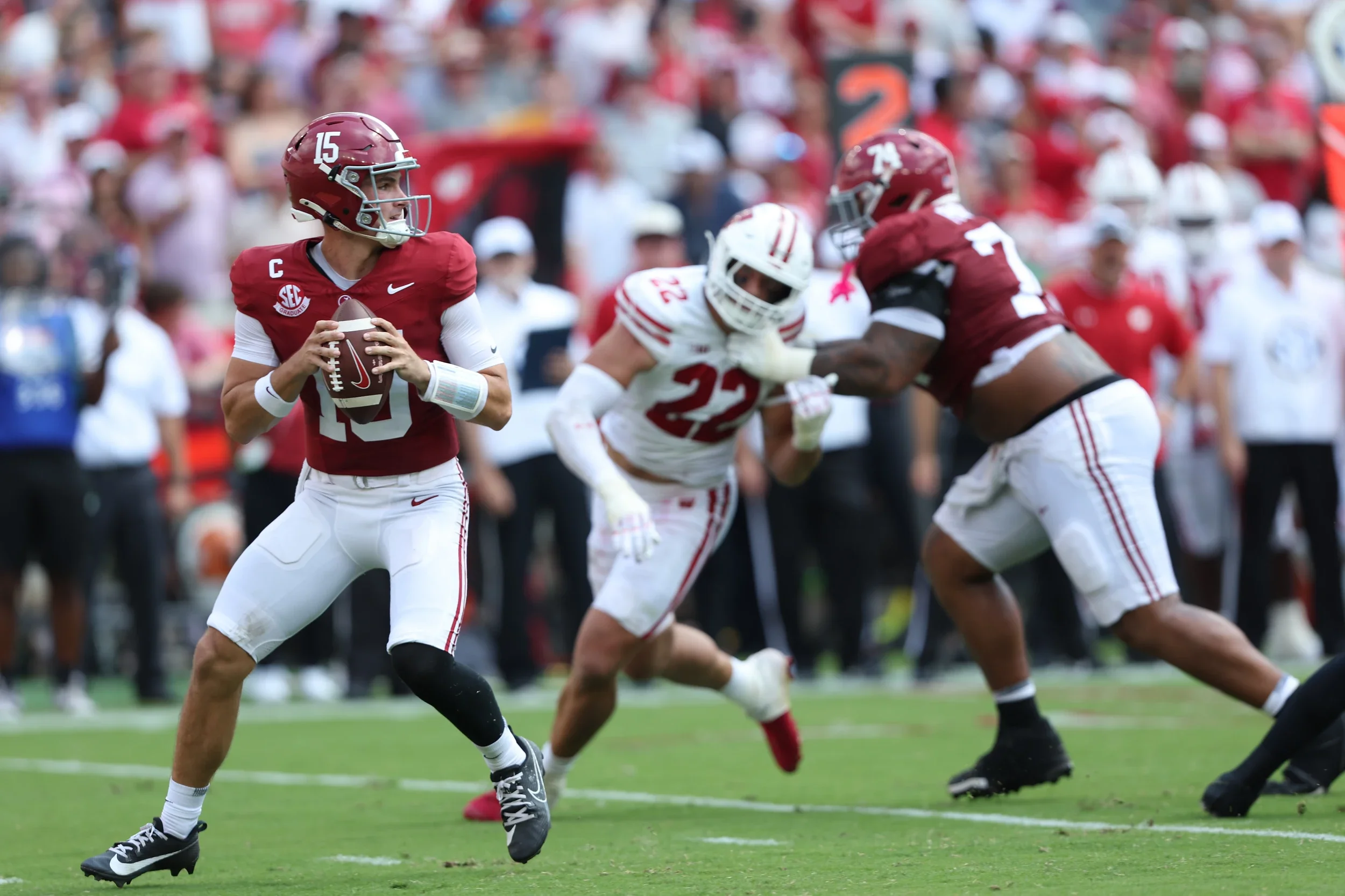Ty Simpson, QB vs Wisconsin 2025
Player: Ty Simpson — QB, Alabama
Height: 6’2”
Weight: 207
Opponent: Wisconsin
Season: 2025
Final Stat Line:
24/29, 382 Yards, 4 TD, 0 INT
6 Carries, 25 Yards
Film Link: Watch on YouTube
Overview
This game film showcases an on-schedule operator who marries play-action rhythm with boundary placement and measured creation when structure breaks. Simpson ties feet to eyes, sells PA, and hits first-window leverage without drifting into chaos; when pockets muddy, he moves with intent—eyes up, base re-set—then chooses between a layered throw or efficient scramble. Several explosive plays throughout the game are quarterback-driven (timing, leverage, ball location).
Usage / Alignment: Heavy shotgun and pistol with frequent PA; under-center PA sprinkled in. Concepts: slot fade/back-shoulder, seams/posts off PA, sideline digs vs zone, plus quick access throws. Scrambling is used as a selective tool, not a personality trait.
Film Review – Key Plays
Play 1) 7:35 1Q, 3rd & 9 - 25 yard Pass
Shotgun formation & the defense blitzes. Simpson hits the top of his drop, steps into the throw, and releases it just before contact arrives, driving a deep out that hits the receiver in stride. This is NFL-caliber timing and placement on 3rd-and-9, converting the first down.
Play 2) 12:15 2Q, 1st & 10 - 45 yard TD Pass
Pistol PA into a deep drop with time; Simpson steps into the throw and drives it down the middle, where it’s caught ~20 yards downfield before the WR slips the first tackle and scores. This play shows on-schedule PA rhythm and intermediate passing to the middle of the field. The ball is out on time with enough velocity to hit the window, then the receiver handles the rest, scoring the TD.
Play 3) 0:51 2Q, 1st & 10 - 13 yard TD Pass
Shotgun play-action with a clean pocket; Simpson throws on time to the post into tight coverage, and it’s secured for the touchdown. This clip shows timing and placement on an in-breaking route into a tight window, with the ball arriving on schedule. What you don’t see in this clip: it capped a composed end-of-half drive where Simpson stacked plays and led the offense down the field—clutch situational execution before the break.
Play 4) 12:42 3Q, 1st & 10 - Scramble & 20 yard Rush
Shotgun with a PA look; two free rushers come from the left and a third closes. Simpson scrambles right, spins out of a sack, reverses back left, then commits to the keep toward the sideline, adds a subtle move on an LB, and steps out after a 20-yard gain. Here we see Simpson show escapability and a decisive run decision on a broken play, turning a likely sack into a 1st down and more.
Play 5) 11:14 3Q, 2nd & 10 - 40 yard TD Pass
Shotgun formation, Simpson drops back and throws to the sideline, hitting a slot fade back-shoulder. Williams secures it, makes a great move on the defenders, and takes it 20 more yards for the touchdown. This throw shows boundary placement and timely delivery on the back-shoulder slot fade, giving the WR a chance to finish with the score.
Play 6) 4:19 3Q, 2nd & 2 - 15 yard Pass
Pistol PA with blind-side pressure coming. Simpson steps up in the pocket to avoid it and fires before another defender gets home, placing it perfectly to the receiver in stride. The receiver adds ~5 more yards before being forced out. This play shows pocket climb and on-time placement under pressure to keep the offense on schedule.
Final Thoughts
This is starter-level tape: accurate on rhythm, confident passing to the middle, and capable of throwing winners to the boundary while mitigating risk. He extends to create throws or to gain efficient yards on the ground, and he protects the football while still creating explosive plays. If he accelerates hot/replace answers when protection busts—and trims the occasional depth drift vs interior push—you’re looking at an every-down operator whose explosives come from process, not variance.
Strengths on Display
Boundary placement to the sideline: On-time, leverage-aware back-shoulder/slot-fade location that protects the ball and sets up YAC.
PA rhythm and middle-field drive: Sells the fake, resets the base, and delivers on schedule with enough velocity to hit interior windows.
Eyes-up pocket movement: Climbs or slides without drifting, keeps the base intact, then triggers on time into vacated zones.
Controlled play extension: Escapes pressure, resets vision, and chooses efficient yards or the throw instead of panicked freelancing.
Areas for Improvement
More verified throws on the move: Put additional on-tape examples of accurate, on-time balls while rolling or resetting outside the pocket; maintain mechanics and ball placement on the run.
Sustain this level vs top SEC defenses: Replicate the timing/placement and clean decision-making against the tougher SEC fronts/coverages to cement the profile.
